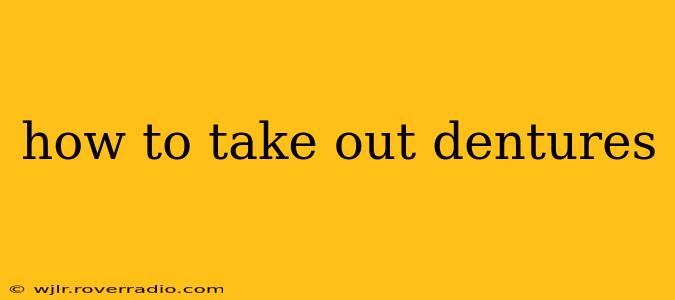Removing dentures can seem daunting at first, but with a little practice and the right technique, it becomes a simple, everyday task. This guide will walk you through the process, addressing common concerns and providing helpful tips for maintaining your oral health.
What are the Different Types of Dentures?
Before diving into removal techniques, it's helpful to understand the different types of dentures. This will influence the specific method you use. There are primarily two main types:
- Complete Dentures: These replace all your natural teeth in either your upper or lower jaw, or both.
- Partial Dentures: These replace only some of your natural teeth, and are held in place with clasps that attach to remaining teeth.
The removal process differs slightly depending on the type, but the general principles remain the same.
How to Remove Full Upper Dentures
Removing full upper dentures requires a gentle yet firm approach. Here’s a step-by-step guide:
- Wash your hands: This is crucial to maintain hygiene and prevent infection.
- Break the seal: Use your thumbs to gently press on the denture’s back, near the very back of your palate. This will help break the suction. Avoid pulling directly downwards.
- Wiggle gently: Once the suction is broken, use your thumbs and index fingers to gently rock the denture back and forth. Avoid jerking or pulling forcefully.
- Remove slowly: Once you feel the denture loosen, carefully remove it from your mouth, moving it downwards and outwards.
How to Remove Full Lower Dentures
Lower dentures can sometimes be more challenging to remove due to the shape of the jaw.
- Wash your hands: Again, hygiene is key.
- Locate the pressure points: Usually, the pressure points are on the sides of the denture.
- Apply pressure: Gently press your index fingers on the sides of the denture.
- Rock and remove: Rock the denture gently back and forth to break the suction. Then, slowly remove it from your mouth.
How to Remove Partial Dentures
Partial dentures are a bit different because they use clasps to attach to your natural teeth.
- Wash your hands: Cleanliness is paramount.
- Identify the clasps: Locate the metal clasps that secure the denture to your teeth.
- Gently unhook the clasps: Use your fingers to gently unhook each clasp one at a time.
- Remove the denture: Once all clasps are unhooked, carefully remove the partial denture.
What if I'm Having Trouble Removing My Dentures?
If you're struggling to remove your dentures, don’t force it. Forcing can damage the dentures or injure your gums. Try these tips:
- Use a mirror: Seeing what you’re doing can help.
- Apply denture adhesive sparingly: Excessive adhesive can make removal difficult.
- Consult your dentist: If you continue to experience difficulty, consult your dentist for advice and guidance. They can assess your situation and offer personalized recommendations.
How Often Should I Remove My Dentures?
It is recommended to remove your dentures at night to allow your gums to rest and to clean both your mouth and the dentures thoroughly.
How Should I Clean My Dentures?
Cleaning your dentures is essential for maintaining oral hygiene and preventing gum irritation. Your dentist can recommend the best cleaning methods and solutions for your specific dentures. Generally, a gentle denture brush and cleaning solution are recommended. Never use abrasive cleaners or hot water, which can damage the dentures.
What are the Signs of Ill-Fitting Dentures?
Ill-fitting dentures can lead to discomfort and oral health problems. Signs include: soreness, difficulty speaking or eating, and persistent loose dentures. If you experience any of these, consult your dentist promptly.
By following these steps and maintaining good oral hygiene, you can ensure comfortable and safe denture removal. Remember, patience and practice are key to mastering this skill. If you have any persistent concerns or difficulties, always seek advice from your dentist or a qualified dental professional.
